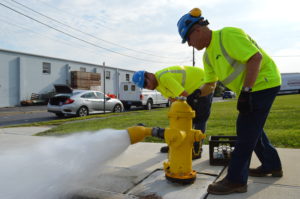Fire Hydrant Maintenance — Yup, We Do That, Too
August 23, 2019LCA crews have been hard at work this summer, flushing, painting and repairing hydrants throughout the city of Allentown.
Maintaining hydrants is an important and ongoing task. Our crews inspect and test over 900 hydrants every year so that they’re in peak condition in case the fire department needs them. We look for leaks, check to ensure they’re easy for fire crews to open, test the hydrant’s water pressure, and repaint the hydrants. We paint an average of 12 hydrants a day.
You may have noticed some of the hydrants have different colors. That’s not random — it’s a special type of code for our firefighters. It helps them determine the appropriate hose hookup and the volume of water the hydrant is able to supply:
- A yellow hydrant denotes a 6-inch lateral (a pipe that runs perpendicular to the water main and supplies the hydrant).
- A yellow hydrant with red cap (the top of a hydrant) denotes a 4 inch lateral.
- A yellow hydrant with a black cap denotes a hydrant that is on a dead end main.
- A silver hydrant with a black cap indicates it’s hooked to one of the city’s four high-elevation systems. This means those areas are fed from elevated water tanks.
Hydrant Flushing

The inspection process is in addition to the yearly flushing program. We flush up to 1,500 hydrants a year. Flushing is a term used when LCA’s crews open valves or fire hydrants in the water distribution system. This moves water through the system to alleviate water quality problems.
We need to flush lines regularly (you can find the hydrant flushing schedule here), because Allentown’s water distribution system is a complex network of pipes and storage tanks where sediment and deposits can naturally accumulate over time, causing water quality deterioration such as discoloration, taste and odor problems if not removed.
Our crews flush the system when we receive customer comments about stale or stagnant water, after a water main break is repaired, and after other types of repairs that may have a water quality impact. We also conduct routine system flushing in certain areas, such as new developments or dead-end water lines, to keep the fresh water moving in the pipes to improve the taste of your water.
Sometimes, residents in the immediate vicinity of the line-flushing work may experience temporary discoloration of their water. This discoloration consists primarily of harmless silt and air and does not affect the safety of the water. If you experience discoloration in your water after crews have been flushing in your neighborhood, clear the pipes in your home by running your water for a few minutes. We recommend using the tub or outside faucet.
If you notice a drop in water pressure, check the screens in your faucet first — they may have debris clogged in them. If water pressure problems or discoloration continue, please contact us.
Two important notes about fire hydrants:
— They should never be used as means to cool off. Not only is it illegal to open a hydrant, it’s extremely dangerous.
First and foremost, hydrants are there in case of a fire. Using the wrong tools to open a hydrant can cause damage, costing firefighters precious time when they’re battling a blaze. And opening a hydrant increases the likelihood that if there is an emergency, firefighters won’t have enough water pressure to adequately battle a blaze. Secondly, when those hydrants are opened, the water that comes out is under a lot of pressure — enough to knock someone over, especially a child.
— They should be kept clear of snow. This is an important but often ignored wintertime task that keeps you safe. Firefighters waste precious time if they have to shovel out a hydrant. To ensure it’s not forgotten, residents should adopt a hydrant on their street.
Ever wonder how fire hydrants work? Check out this helpful YouTube video.